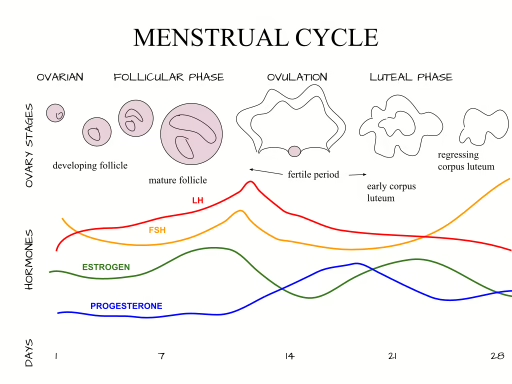🌗 Where nervous system wisdom rewrites the perimenopause playbook—part of The Reckoning Years series.
Your cycle used to just show up.
Now it announces itself like a marching band in combat boots.
- Your gut freaks out
- You cry over nothing
- Your joints ache
- Your sleep crashes
- Your fuse? Gone
You’re not imagining it. You’re not failing at self-care.
Your cycle is no longer a whisper. It’s a siren.
And that’s not dysfunction—it’s information.
The Monthly Checkpoint You Can’t Ignore
Your luteal phase (the second half of your cycle) is now a capacity audit.
Whatever you haven’t dealt with—physically, emotionally, metabolically—gets amplified here.
What was once buffered now breaks through.
That fight you’ve been avoiding? It shows up as irritability you can’t stuff down.
The skipped meals and late-night screen time? They cash out as 3 a.m. cortisol jolts.
The unresolved stress at work? Your nervous system reruns it on loop when progesterone dips and can no longer calm the circuitry.
This isn’t your body betraying you—it’s your body refusing to collude with your old compensation patterns.
Estrogen volatility sharpens your perception; progesterone withdrawal removes the brake pedal.
Suddenly, all the leaks in your system—gut inflammation, blood sugar swings, sleep debt, unspoken resentment—are lit up in neon.
It’s uncomfortable, yes. But it’s also precise.
Your cycle is running a monthly audit, pointing straight at the places your system can no longer afford to subsidize.
Ignore it, and the siren gets louder.
Work with it, and you start rebuilding capacity instead of hemorrhaging it.

What’s Actually Making Your Cycle So Loud
our luteal phase isn’t out to sabotage you—it’s unmasking what was already thin.
In your twenties, progesterone buffered stress. Estrogen rose and fell with a softer edge. Your gut and liver had margin, so clearance happened in the background.
By perimenopause, that scaffolding thins. Progesterone collapses first, pulling GABA down with it. Estrogen starts to spike and stall, asking more of the liver. Histamine rides the wave, which is why you suddenly can’t tolerate wine, cheese, or pollen the way you used to. Minerals like magnesium, already depleted by years of stress and caffeine, become the missing stabilizer. Add gut-liver slowdowns—constipation, sluggish bile, stress-braced digestion—and the drain is clogged.
The result isn’t random. It’s predictable overload.
A cycle that used to whisper is now blaring through the speakers, saying:
“Pay attention—your buffer is gone.”
Your Cycle is a Barometer, Not a Betrayal
Instead of asking:
“Why is this happening to me?”
Try:
“What truth is trying to surface?”
Because when your body can no longer buffer imbalance, it starts to broadcast it.
That’s not weakness.
It’s intelligence.
🌟Through the Vital Clarity Code Lens
🌱 Regulate
Begin by honoring rhythm—even if messy. Predictability calms the nervous system.
Ask yourself:
- Do you know where you are in your cycle?
- Do you eat consistently, or only when symptoms spike?
- Do you allow quiet to surface before the siren does?
This phase is about calming the terrain, not fixing the signal.
Micro-Regulate tip: daily unbracing = less monthly blowup.
You don’t need a tracker app—just a felt sense of rhythm (the Perimenopause Diary from CEMCOR)
🌀 Rewire
Support clearance. Your body can’t release what it doesn’t have capacity to move.
Enter the bathtub analogy: fill → process → drain.
- When the drain (constipation, poor bile flow, stress-braced digestion) is slow, estrogen backs up.
- When estrogen lingers, everything gets louder: cramps, breast tenderness, mood swings, sleep disruption.
When the drain is slow (constipation, poor bile flow, stress-braced digestion), estrogen backs up.
And when estrogen lingers, everything gets louder: cramps, breast tenderness, mood swings, sleep disruption.
Rewiring here = opening exits, not restricting inputs.
Think gentle liver/gut support (castor packs, bitters, dry brushing) + mineral repletion.
🔥 Reclaim
This is the moment you realize your cycle was never the enemy.
You’ve been taught to resent bleeding and mood swings.
But this rhythm isn’t punishing you—it’s signaling you.
Your cycle isn’t broken. It’s a biofeedback loop.
When we listen—without panic, shame, or control—we begin to reclaim our rhythm as a vital sign, not a flaw.
✨ Resonate
There’s a phase beyond managing symptoms—
a season where rhythm feels like rhythm again, not chaos.
Imagine bleeding without bracing for collapse.
Imagine the luteal week as a built-in honesty mirror instead of a war zone.
Imagine estrogen’s peaks as energy to ride, not crashes to fear.
This isn’t fantasy—it’s coherence. It comes when the exits are open, the nervous system has margin, and the signal is no longer distorted by overload.
Resonance doesn’t erase the cycle.
It transforms it from siren into symphony.
🪶Micropractice: Cycle Sync Check-In
Pick one anchor this week—food, sleep, or movement.
Then ask:
“What is this part of my cycle asking me to shift?”
In luteal phase → less stimulation, more protein, gentler movement
During bleed → pause, even briefly, to acknowledge the signal
TL;DR
Your cycle is louder because your system is full.
Estrogen isn’t misbehaving—it’s waiting for a clear exit.
Your body isn’t overreacting—it’s signaling capacity limits you’ve been pushing through.
When we support clearance and stop fighting the signal, the screaming quiets.
What’s left is wisdom.
The siren isn’t screaming because you’re weak.
It’s screaming because you can finally hear it.
Your siren isn’t random—it’s a roadmap.
I’ll help you read the signals and reclaim your capacity.
Explore the Vital Signal Check →
